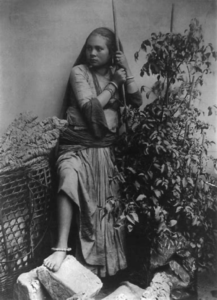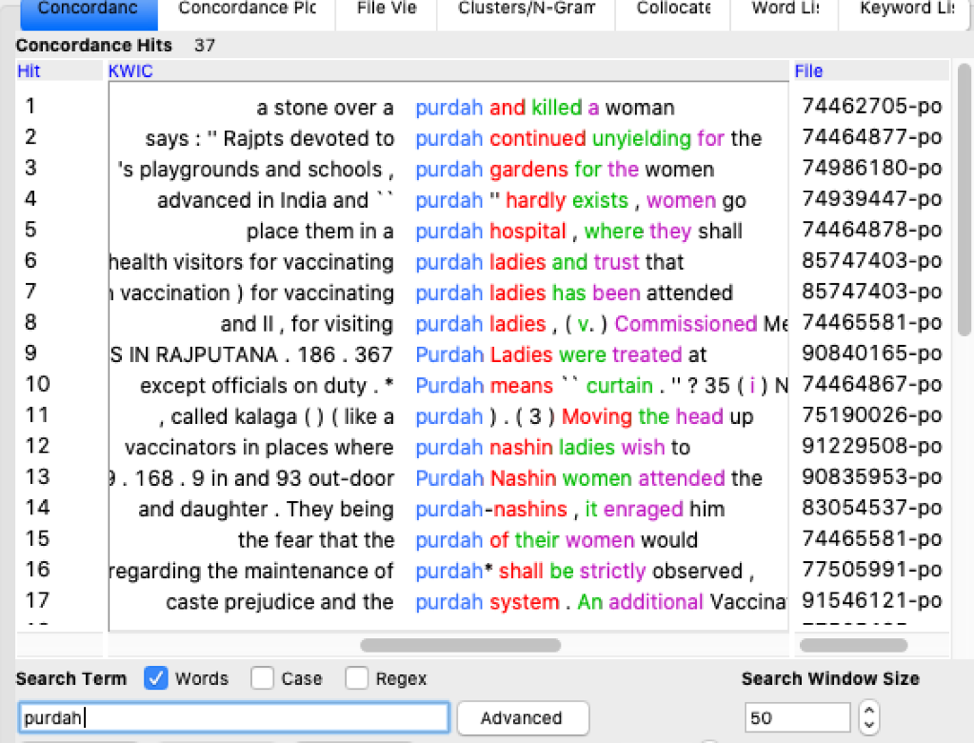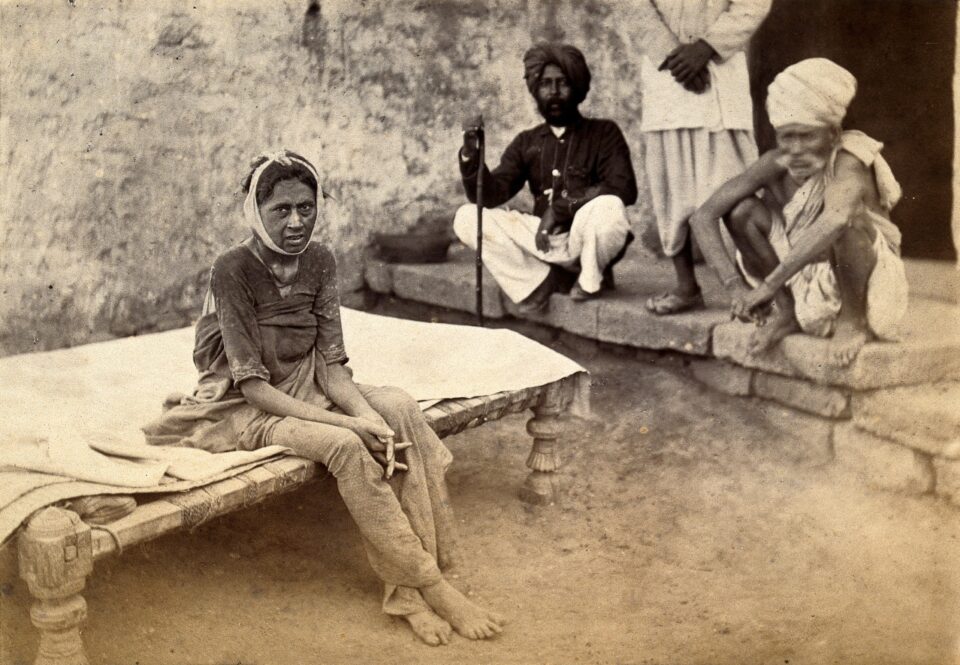By Le Zhang

As Klein, Lauren F suggested, when looking at the historical archive, we should look not only at what it says, but also at what it does not say (Klein, 688); not only what does it record, but in what way does it record. In the Medical History of British India which is full of male discourse and colonialist perspectives, I want to explore the hidden fate of Indian women, especially the 'coolie women'.
At first, I searched 'coolie' on WordNet Search and found that 'coolie', or 'cooly', is an offensive name for an unskilled Asian laborer. Then I search the keyword 'Coolie *' at Antconc and found 392 appearances. Then I search Clusters/N-gram and find 'Coolie Wom?n' 191; 'Cooly wom?n' 7; 'Cooly Girl' 2; 'Coolie girls' 1, which are mostly none plurals or none. We can find that 'coolie women,' as a marginalized group in British India, were rarely recorded by the government and hidden in the corners of the archives. After reading each document about the query to the 'coolies women,' I find that they were discriminated and stigmatized physically and mentally. The unfair treatment came from the discard of the traditional Indian society, exploitation of factory owners, bullying of colonial soldiers and expelling of colonial government. These pressures on women workers made it difficult for them to escape their tragic fate. The high mortality rate, low cure rate and low life expectancy are the best evidence, which are worth finding and thinking about.
Upper class Indian women who abide by the purdah system
In the traditional Indian society, Indian women scrupulously observed the purdah system and were isolated from society outside the home (Egel,19). However, the invasion of the British colonists destroyed the traditional Indian family and profoundly affected the fate of Indian women.
Some upper-class Indian women were still sheltered by their families and observed the tradition of purdah. Even when vaccinated, they objected to the contact of male doctors and allowed only female doctors to see them and vaccinate them. They were known as 'Purdah Ladies' (See Figure 1) and the British government sent special female doctors to treat the Indian women (See Figure 2).

Figure 1 Search of ‘Purdah’ in Antconc

Figure 2 Search of ‘Purdah’ in Antconc
Difficult survival: 'coolie women' abandoned by traditional Indian society
But the collapse of the traditional economy had left India's lower-class women forced to work in factories, doing heavy drudgery to survive. In this process, they were insulted and damaged, and many 'coolie women' engaged in illegal sex work. The fate of these 'coolie' women was very tragic.
'Coolie women' were engaged in heavy labor under harsh conditions. According to Beyond purdah? in British India, the working conditions in factories, mines and plantations were generally extremely poor. For example, some tea factories were sweltering. So, diseases such as malaria, hookworm, dysentery, and diarrhea were prevalent (Engels, 216). In some textile mills the air was dirty and the machines lacked protective equipment. In a work environment like this, people can easily get sick or have accidents in it.
Under such circumstances, women often did heavy work in factories for truly little pay. And for the same work, female workers were paid less than male 'coolies' (see Figure 3). A search for 'heavy work' on Antconc reveals the plight of female workers.

Figure 3. Search of ‘heavy work’ in Antconc
To make matters worse, migrant women left their rural families and were seen as castless, their status in Indian society plummeted (Engels, 212). As a result, women workers were not only economically impoverished and relegated to the bottom of society; but also socially despised, spurned and excluded from Indian caste society.
Being abused, discriminated, and expelled:'coolie woman' reduced to illegal prostitutes
In order to survive and protect themselves, many 'coolie women' who cannot make ends meet had to rely on men or even become illegal sex workers. They often served British soldiers. British and Indian medical records show that the army patronized these women because of their low cost (see Figure 4). These forced female coolies were humiliated and discriminated against by the soldiers. In the soldiers' eyes, their status was inferior to that of 'decent' prostitutes. · They were called 'dirty Women'(see Figure 5).

Figure 4. Search of ‘coolie’ in Antconct

Figure 5. Search of ‘dirty women’ in Antconc
Moreover, female 'coolies' were also expelled and insulted by the British government. In order to ensure the health of the soldiers, the British government sent the police to take compulsory measures to surveillance, control and drive away or arrest suspicious women from loitering near the barracks (see Figure 6). This means not only discriminating against these women, but also stifling their economic resources, legitimacy, humanity, and freedom.



Figure 6. Search of ‘coolie women’,‘cooly women’,‘coolie’
The archives of British Indian medical history even regarded these female 'coolies' as the source of the disease, regardless of the role played by soldiers in the transmission of the disease (see Figure7).



Figure 7 Search of ‘coolie women’ and ‘cooly women’
The result was a high incidence of disease and harsh living conditions, as well as mental and physical torture, resulting in a short life span and a high mortality rate for these female 'coolies'. What’s more, it is obvious that the tragic fate of these female 'coolies' extends to their children, as shown in the data, at least half of the children died before they grew up (see Figure8).

Figure 8 Search of ‘coolie women’ in Antconc
Through Antconc analysis, we can find the tragic fate of Indian 'Coolie women' in British India medical history, which cannot be found easily through reading the material directly. These 'coolie' women's voices deserve to be heard. We need to pay more attention to and care about female’s destiny in India.

(https://cn.bing.com/images/search?q=coolie+women&FORM=HDRSC2)
Works Cited
Engels, Dagmar. Beyond Purdah? Women in Bengal 1890-1939. Oxford University Press, 1996.
Klein, Lauren F. ‘The Image of Absence: Archival Silence, Data Visualization, and James Hemings.’ American Literature, vol. 85, no. 4, 2013, pp. 661–88.doi: doi-org.ezproxy.is.ed.ac.uk/10.1215/00029831-2367310
Manmohan Kaur. Women in India's Freedom Struggle. Third ed., Sterling, 1992.
Tuhiwai, Smith, Professor Linda. Decolonizing Methodologies: Research and Indigenous Peoples, Zed Books, 2012. ProQuest Ebook Central, ebookcentral.proquest.com/lib/ed/detail.action?docID=1426837.
1 In AntConc, the “?” symbol denotes any one character, the “*”symbol denotes zero or more characters. These symbols allowed me to search for different forms of each word at the same time. For example: “wom?n” found results for “woman” and “women”; “Coolie*” found results for “Coolie” or “Coolies”

